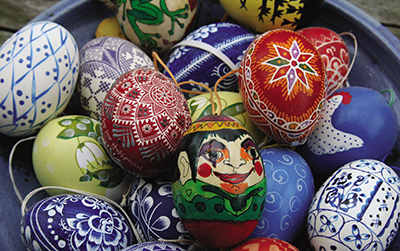
By Sean Delaney
Easter 2022 may be the first holiday where families get together comfortably and without worry for quite some time. And in the spirit of that, we wanted to highlight and tell the story of, one of the world’s more beautiful Easter traditions, and just how you can practice this activity with children and grandchildren.
Of added benefit for this time, is the ability to shed light on a beautiful tradition of a people feeling oppressed right now.
It is the Ukrainian Easter Egg.
A pysanka is a Ukrainian Easter egg, decorated using beeswax and dyes. The word comes from the verb pysaty, “to write”, as the designs are not painted on, but written with beeswax, explains Wikipedia.
The process of wax-resist egg decorating dates back to pre-Christian era, particularly in Slavic cultures where it is a popular tradition. No ancient examples of the eggs remain however the symbols used and fragments that have been found in countries like Poland show the tradition has been around for quite some time, and informed archeologists on the process used.
In ancient times, Ukrainians worshipped a sun god, Dazhboh. The sun was the source of warmth and of all life. Because of this worshipping of the sun, it became popular to create eggs as a tribute.
Dazhboh was an important god in the pre-Christian Slavic cultures and birds were held in high esteem as well. Birds were not only a creation of the gods but seen as one of the only creatures that could get close to them, likely due to their ability to fly.
Eggs then were an important item for people of these times. They were the part of the bird a human could obtain easily and a perfect choice for a tribute. It is said that many believed the eggs also had power.
As Christianity grew in popularity the symbolism of the egg changed quite a bit, however it remained a tradition to create them.
The egg was said to no longer represent nature’s rebirth. With the widespread acceptance of Christianity in 988, Christians took on the egg to represent Easter and Christ’s believed rebirth. Because of this, the importance of the egg remained, and many of the old symbols used to celebrate the sun god and sun worship simply became adapted to the new Christian beliefs surrounding the egg.
The tradition of the Ukrainian Easter Egg, like so many other parts of North American culture was then a gift of immigration. Ukrainian immigrants to North and South America carried the tradition with them and taught it far and wide.
And the egg has survived a historic bit of adversity as well.
The Soviet Union banished the practice in the Ukraine, as a religious practice, and the tradition was almost lost.
However, Ukraine achieved its independence in 1991, and the tradition was revived despite the Soviets destroying many museums and archives where artifacts preserving the tradition had been held.
Now, how to create your own...














